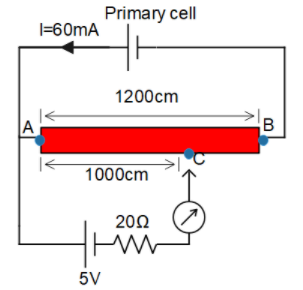
The length of a potentiometer wire is $1200cm$ and it carries a current of $60mA$. For a cell of emf $5V$ and internal resistance of $20\Omega $, the null point on it is found to be at $1000cm$. The resistance of the whole wire is:
A. $60\Omega $
B. $100\Omega $
C. $80\Omega $
D. $120\Omega $
Answer
575.4k+ views
Hint: The potentiometer wire works on the principle – the potential drop across a given part of wire is directly proportional to the length of that part of the wire. The resistance of the potentiometer wire can be found by firstly finding the potential drop across the potentiometer. Using the potential drop across potentiometer wire, we can find the resistance using Ohm’s Law.
Formula used:
${R_{AB}} = \dfrac{{{V_{AC}}}}{I} \times \dfrac{{{L_{AB}}}}{{{L_{AC}}}}$
Complete answer:
First and foremost, we’ll draw a rough circuit diagram, for better understanding.

In the diagram,
$AB$ is the potentiometer wire
$C$ is the null point
$I$ is the current passing through the potentiometer wire.
From the diagram, we’ll first find the potential drop across, AB using the balancing length of potentiometer formula. It is given by
$\dfrac{{{V_{AB}}}}{{{L_{AB}}}} = \dfrac{{{V_{AC}}}}{{{L_{AC}}}}$
We have, ${L_{AB}} = {\text{ }}1200cm$, ${V_{AC}} = {\text{ }}5V$, ${L_{AC}} = {\text{ }}1000cm$. So, by solving for ${V_{AB}}$
$\eqalign{
& \dfrac{{{V_{AB}}}}{{{L_{AB}}}} = \dfrac{{{V_{AC}}}}{{{L_{AC}}}} \Rightarrow {V_{AB}} = \dfrac{{{V_{AC}}}}{{{L_{AC}}}} \times {L_{AB}} \cr
& \Rightarrow {V_{AB}} = \dfrac{{5V}}{{1000cm}} \times 1200cm \cr
& \Rightarrow {V_{AB}} = 6V \cr} $
Now, using Ohm’s Law, we can find the resistance of potentiometer wire. From ohm’s law we have
${V_{AB}} = I{R_{AB}} \Rightarrow {R_{AB}} = \dfrac{{{V_{AB}}}}{I}$
Here
${R_{AB}}$ is the resistance of potentiometer wire
$I$ is the current passing through the potentiometer wire
${V_{AB}}$ is the potential drop across the potentiometer wire
$\eqalign{
& \Rightarrow {R_{AB}} = \dfrac{{6V}}{{60 \times {{10}^{ - 3}}A}} = 100\Omega \cr
& \therefore {R_{AB}} = 100\Omega \cr} $
Therefore, the correct option is B.
Note:
The principle of potentiometer wire is dependent on potential gradient. It is given by,
$K = \dfrac{{dV}}{{dx}}$ $B.{\text{ }}100\Omega $
Where
$K$ is the potential gradient
$V$ is voltage
$x$ is the length of displacement
differentiation with respect to x indicates the rate of change of voltage with respect to the length.
For a given wire of the same physical properties, the potential gradient is constant.
Formula used:
${R_{AB}} = \dfrac{{{V_{AC}}}}{I} \times \dfrac{{{L_{AB}}}}{{{L_{AC}}}}$
Complete answer:
First and foremost, we’ll draw a rough circuit diagram, for better understanding.

In the diagram,
$AB$ is the potentiometer wire
$C$ is the null point
$I$ is the current passing through the potentiometer wire.
From the diagram, we’ll first find the potential drop across, AB using the balancing length of potentiometer formula. It is given by
$\dfrac{{{V_{AB}}}}{{{L_{AB}}}} = \dfrac{{{V_{AC}}}}{{{L_{AC}}}}$
We have, ${L_{AB}} = {\text{ }}1200cm$, ${V_{AC}} = {\text{ }}5V$, ${L_{AC}} = {\text{ }}1000cm$. So, by solving for ${V_{AB}}$
$\eqalign{
& \dfrac{{{V_{AB}}}}{{{L_{AB}}}} = \dfrac{{{V_{AC}}}}{{{L_{AC}}}} \Rightarrow {V_{AB}} = \dfrac{{{V_{AC}}}}{{{L_{AC}}}} \times {L_{AB}} \cr
& \Rightarrow {V_{AB}} = \dfrac{{5V}}{{1000cm}} \times 1200cm \cr
& \Rightarrow {V_{AB}} = 6V \cr} $
Now, using Ohm’s Law, we can find the resistance of potentiometer wire. From ohm’s law we have
${V_{AB}} = I{R_{AB}} \Rightarrow {R_{AB}} = \dfrac{{{V_{AB}}}}{I}$
Here
${R_{AB}}$ is the resistance of potentiometer wire
$I$ is the current passing through the potentiometer wire
${V_{AB}}$ is the potential drop across the potentiometer wire
$\eqalign{
& \Rightarrow {R_{AB}} = \dfrac{{6V}}{{60 \times {{10}^{ - 3}}A}} = 100\Omega \cr
& \therefore {R_{AB}} = 100\Omega \cr} $
Therefore, the correct option is B.
Note:
The principle of potentiometer wire is dependent on potential gradient. It is given by,
$K = \dfrac{{dV}}{{dx}}$ $B.{\text{ }}100\Omega $
Where
$K$ is the potential gradient
$V$ is voltage
$x$ is the length of displacement
differentiation with respect to x indicates the rate of change of voltage with respect to the length.
For a given wire of the same physical properties, the potential gradient is constant.
Recently Updated Pages
Master Class 12 Business Studies: Engaging Questions & Answers for Success

Master Class 12 Economics: Engaging Questions & Answers for Success

Master Class 12 English: Engaging Questions & Answers for Success

Master Class 12 Maths: Engaging Questions & Answers for Success

Master Class 12 Social Science: Engaging Questions & Answers for Success

Master Class 12 Chemistry: Engaging Questions & Answers for Success

Trending doubts
What are the major means of transport Explain each class 12 social science CBSE

Which are the Top 10 Largest Countries of the World?

Draw a labelled sketch of the human eye class 12 physics CBSE

Explain sex determination in humans with line diag class 12 biology CBSE

The pH of the pancreatic juice is A 64 B 86 C 120 D class 12 biology CBSE

Explain sex determination in humans with the help of class 12 biology CBSE




